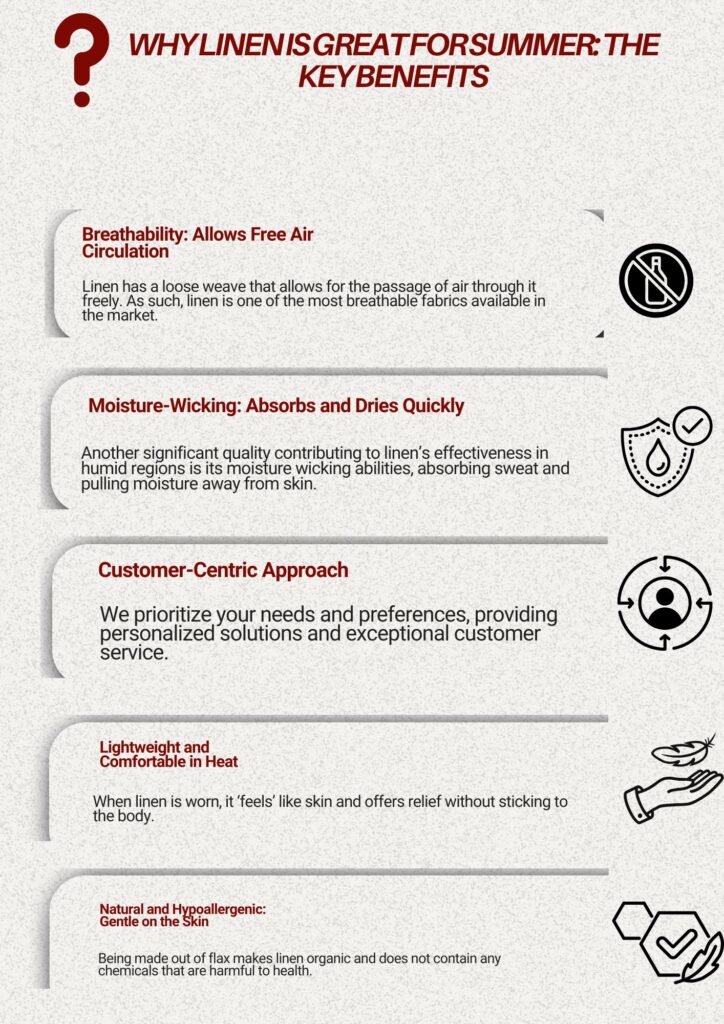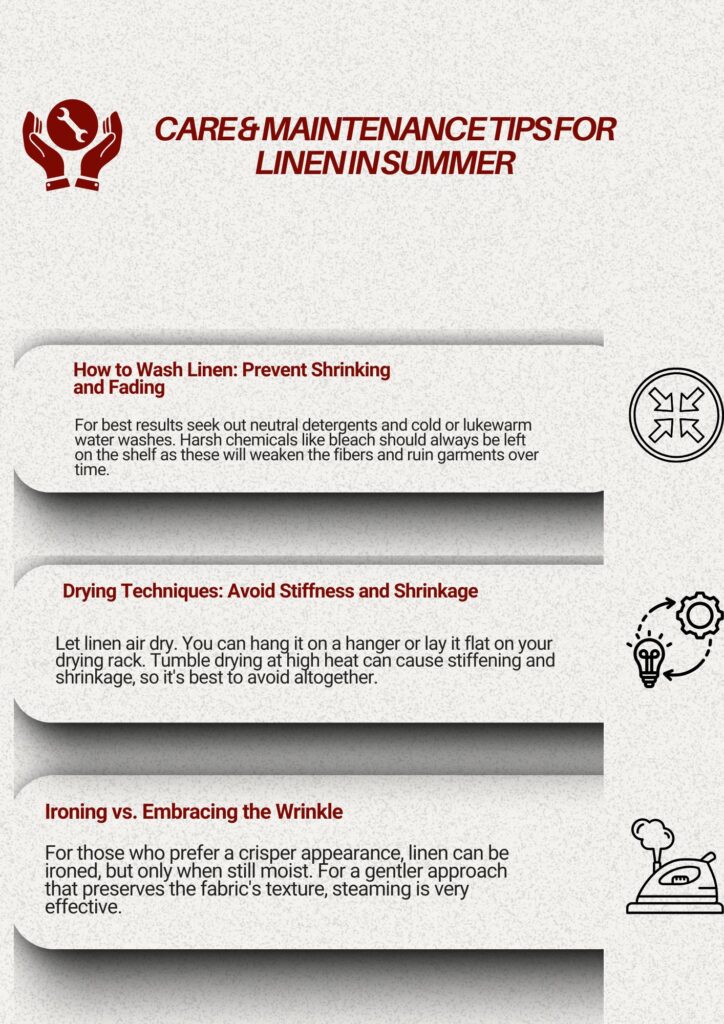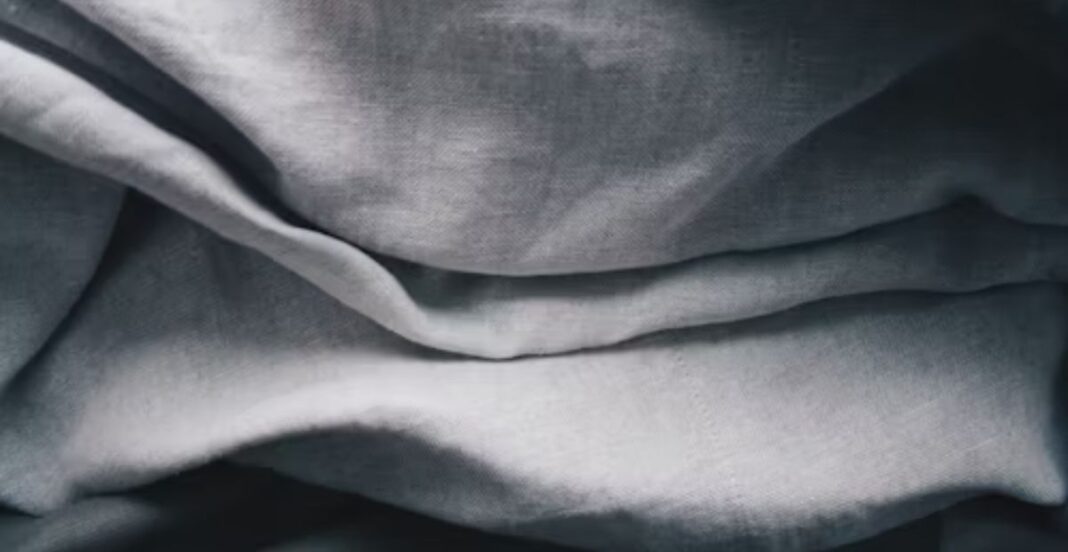Introduction
One of the oldest textiles in the world, Linen is a fabric produced from the flax plant. For centuries, it has been favored as a garment for warm climates due to its breathability. In fashion and home decor, linen’s natural texture, earthy color, and crisp feel give it an enduring quality. However ,the question on people’s minds today is whether linen is ideal for summer wear. There is a greater need to find sartorial solutions as temperatures increase while dew points remain high. Beyond looking good, shoppers expect:Is linen good for summer?
In this article we are going to understand why it continues to be considered a staple during summers and emphasize its advantages over other fabrics .By the end of the article we will help you make an informed decision if it’s ideal for hot weather or not.
Why Linen is Great for Summer: The Key Benefits

Breathability: Allows Free Air Circulation
Linen has a loose weave that allows for the passage of air through it freely. As such, linen is one of the most breathable fabrics available in the market. During summer months, wearing linen helps remain cool during hot weather. Linen is an excellent fabric for summer lounging, travelling and outdoor activities due to its breathability. Unlike synthetic fabrics that restrain the heat from escaping, rubber – synthetics products allow limited airflow which increases comfort in non-exercising outdoors scenarios.
Moisture-Wicking: Absorbs and Dries Quickly
Another significant quality contributing to linen’s effectiveness in humid regions is its moisture wicking abilities, absorbing sweat and pulling moisture away from skin. It then releases it into the atmosphere maintaining dryness while ensuring comfort. This ability keeps absorbent clingy discomfort often experienced with other synthetic fabrics off users’ skins especially during summer months devoid of bathing suit aid or avoiding sticky business attire when not suited up actively at work.
Lightweight and Comfortable in Heat
When linen is worn, it ‘feels’ like skin and offers relief without sticking to the body.
Linen maintains one’s freshness during walks or due to its cool texture and light weight. Whether sitting on the beach or walking outdoors, it helps you feel free and refreshed.
Natural and Hypoallergenic: Gentle on the Skin
Being made out of flax makes linen organic and does not contain any chemicals that are harmful to health. It also does not cause any allergic reactions hence suitable for sensitive skin and those who tend to suffer from allergies.
Due to its hypoallergenic properties, linen is often preferred by people suffering from eczema or other skin sensitivities as it does not cause irritation like synthetic blends do.
UV Protection: Better Sun Shield Than Cotton
The fabric also possesses an advantage of blocking unwanted rays from the sun. The tight weave and thicker fiber of linen offers more protection compared to cotton or most synthetic fabrics.
This means wearing linen reduces the risk of getting sunburnt or long-term skin damage. Thus protecting the skin more, makes it another reason why using linen is beneficial during summer and when there is prolonged exposure outdoors.
Linen vs. Other Summer Fabrics: Is Linen Good for Summer Compared to the Rest?
Linen vs. Cotton: Which Keeps You Cooler?
While Cotton is considered a “summer fabric”; linen surely outdoes it in more than one ways. Moreover soft cotton, does not dry as quickly as linen even when damp. Dampness from cotton gets very uncomfortable on hot days due to humid weather.
On the other hand, fabrics like linen release sweat faster and breathe better during intense heat. Further, it remains cool for many hours at heat, even after staying under the sun for long periods of time. So, answering the question does compare К was asked how does linen sweater withstand compares between himself and cotton?
Linen vs. Bamboo: Which Lasts Longer and Feels Cooler?
Bamboo fabric is smooth to the touch, as well as soft and silken. Nevertheless, it does not outperform linen in breathability and durability. Bamboo wears down rather quickly compared to linen which gets softer over time.
Both materials are breathable; however, linen provides a sharper and crisper texture that is more refreshing than bamboo. Linen also outlasts bamboo when it comes to retaining shape under high temperatures.
Linen vs. Polyester: Why Synthetics Fall Short
Summer polyester wear is not recommended because while looking sleek, polyester traps heat and does not allow for sweat evaporation. This leads to overheating alongside skin irritation.
Linen on the other hand allows the body to maintain a cooler temperature naturally without trapping heat like polyester does. It is also sustainable, airy, and non toxic – everything polyester lacks. Linen approaches comfort and skin health far better than polyester ever could makes it markedly superior.
Best Linen Clothing for Summer: What to Wear and How
Top Linen Picks: Shirts, Dresses, Pants & Suits
Linen is a very versatile fabric for summer outfits. Many people prefer linen shirts since they are neat looking and have a relaxed fit. For complete effortless style, there’s the linen dress which offers breathable coverage. Linen pants are light, loose and perfect for everyday wear. Even suits made out of linen have become trendy for summer weddings and other events
These items not only help in keeping your body cool, but also aid in maintaining style without exerting effort.
Styling Tips for a Summer-Ready Linen Look
For a clean, fresh look, pair pastel or neutral hues with linen. A classic example would be beige trousers complemented by a white linen shirt. Straw hats and hip leather sandals complete the outfit while adding an extra touch of elegance.
While it’s true that layering isn’t needed with these garments, if mandatory it has to be kept simple – like a cotton tank under linen shirt combination.
Best Linen Colors for Summer: Light Shades Reflect Heat
In summer, lighter shades such as white, cream, blush, and soft blue not only give a refreshing look but also reflect sunlight while pairing seamlessly with linen. On the contrary, dark colors tend to absorb heat which increases sweating.
Selecting pale tones enhances off- white hues of summer season while giving more options in styling linen outfits. Boosting your style is an added benefit too.
Potential Drawbacks of Linen in Summer
Wrinkles Easily But That’s Part of the Charm
Pale-colored crisp linen wrinkled easily which gives a relaxed look overall. Some individuals dislike this aspect of textile whereas others love the ‘lived-in’ charm. Texture wise creases add character and showcase natural fabric beauty.
For those who prefer smooth garments opt for steamers or choose blends with linen fabrics while keeping in mind that relaxed trenches is appealing too.
Can Be Pricey Compared to Cotton
Good quality linen tends to be pricier than cotton; however, its durability enhances its timeless appeal, making it a worthy investment in the long run.
Purchasing linen is a long-term investment in both comfort and style. There are cheaper blends of linen available, but these may sacrifice breathability and luster.
Needs Proper Care for Longevity
Linen requires some specific cleaning protocols that include gentle washing to maintain a crisp appearance after ironing, as well as avoiding rough detergents or hot drying cycles.
If properly maintained, linen remains beautiful and durable for many years.
How to Choose High-Quality Linen for Summer Wear
Go for 100% Pure Linen Avoid Blends for Best Results
Always remember to check the label before purchasing. Pure linen naturally has all the cooling and comfort properties. Blends may appear similar but will not perform the same during hot weather.
For optimal performance during summer, rely on 100% flax based linens.
Check the Weave: Looser Means More Breathable
A sample checkout can be done by touching and feeling the fabric. Something very structured such as a loose weave offers more breathable air flow due to increased looseness, but if woven air is too thin then it could counterbalance breathability which equals tempered balance.
Many fine European linens strike a delightful equilibrium between strength and breathability which is ideal.
Best Linen Brands for Summer Fashion
Eileen Fisher, Luca Faloni, Quince, and MagicLinen are popular names among consumers because they offer quality linen. These companies prioritize sustainable materials, precise craftsmanship, and transparent business practices.
Choosing a reputable brand ensures enhanced quality, greater comfort, and increased resilience during warm weather.
Care & Maintenance Tips for Linen in Summer

How to Wash Linen: Prevent Shrinking and Fading
For best results seek out neutral detergents and cold or lukewarm water washes. Harsh chemicals like bleach should always be left on the shelf as these will weaken the fibers and ruin garments over time.
Although handwashing is ideal, gentle machine washing works too.
Drying Techniques: Avoid Stiffness and Shrinkage
Let linen air dry. You can hang it on a hanger or lay it flat on your drying rack. Tumble drying at high heat can cause stiffening and shrinkage, so it’s best to avoid altogether.
If you must tumble dry, use low heat and keep it on the lowest setting. Linen items should be taken out while slightly damp.
Ironing vs. Embracing the Wrinkle
For those who prefer a crisper appearance, linen can be ironed, but only when still moist. For a gentler approach that preserves the fabric’s texture, steaming is very effective.
Nonetheless, many lovers of linen overlook ironing in favor of its supple, crumpled beauty which contributes to relaxed summer style.
Frequently Asked Questions (FAQs)
Is Linen Cooler Than Cotton?
Certainly, linen is cooler than cotton. It dries faster and “breathes” better, making it perfect for hot summer days.
Does Linen Get Softer Over Time?
Yes, indeed! With every wash, linen becomes softer. Eventually, it acquires a buttery smooth texture while retaining strength.
Can I Wear Linen in Humid Climates?
Most definitely. The humid weather makes it even stickier; thus the moisture wicking freshness of linen keeps away stickiness as well as sweat build up.
How Do I Stop Linen From Wrinkling So Much?
Although preventing wrinkles entirely isn’t possible, there are ways to mitigate their appearance. Employ steam, damp ironing, or don linen blend fabrics for optimal results. Neatly folding and properly storing garments contributes as well.
Conclusion
Beyond simply a garment, linen serves lively purposes during summer. Its remarkable breathability makes the wearer’s body feel cooler, and protects it from excessive heat while offering comfort and looking good.
Despite its higher price range, its invaluable investment linen provides during summer due to immense timeless style and comfort is unmatched making it the best fabric.
Experience this difference yourself Bradford feels sure to amaze permanently shifting one’s gaze towards effortless accentuated dressing in summer.


